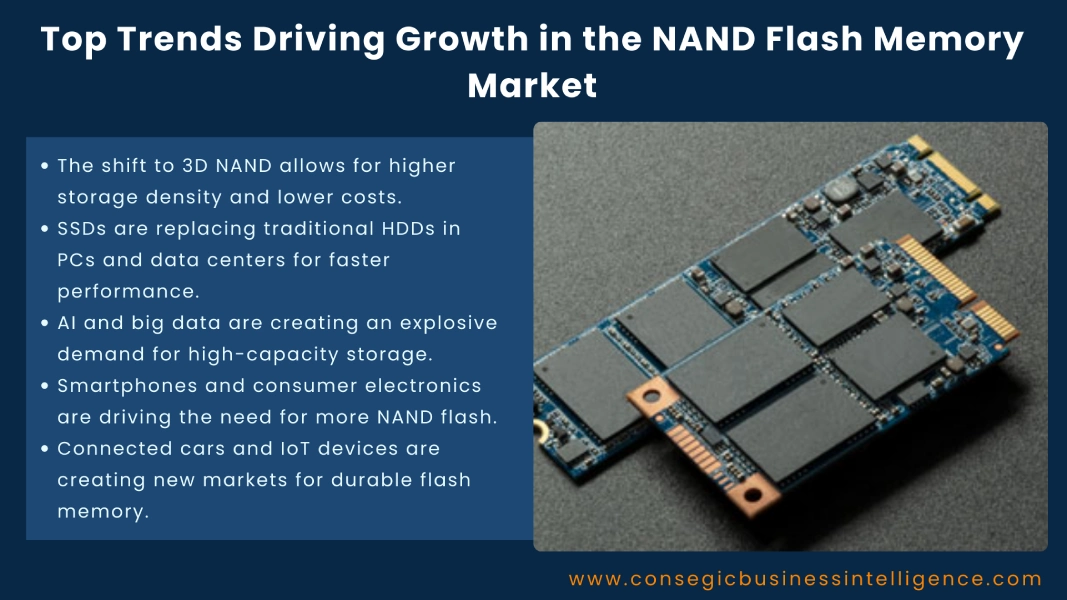Top Trends Driving Growth in the NAND Flash Memory Market
NAND flash memory has become the backbone of modern data storage, powering everything from smartphones and laptops to enterprise servers and automotive systems. Moreover, its compact size, high density, and ability to retain data without power make it indispensable in a digital-first world. As the demand for faster, more efficient, and durable storage continues to rise, the NAND flash memory market is witnessing strong global growth.

A combination of technological innovations, market dynamics, and expanding applications is shaping the future of NAND.
Below are the top trends driving growth in the NAND flash memory market.
- Transition to 3D NAND Technology
One of the most influential trends in the market is the widespread shift from planar NAND to 3D NAND technology. By stacking memory cells vertically, 3D NAND allows for higher storage density, better performance, and lower cost per bit. Leading manufacturers are now producing chips with over 200 layers, delivering immense capacity for enterprise data centers and consumer electronics. This evolution is enabling devices to handle greater workloads while remaining compact and affordable.
- Demand from Smartphones and Consumer Devices
Smartphones remain one of the largest consumers of NAND flash, thanks to growing requirements for high-resolution photos, 4K/8K video recording, and large application libraries. Additionally, tablets, gaming consoles, and wearables are further boosting demand. As consumers increasingly store rich media content and adopt 5G-enabled devices, the need for faster and more reliable NAND solutions is escalating. This sector continues to be a major growth driver for the market.
- Rising Adoption in Data Centers and Cloud Computing
Data centers and cloud platforms are rapidly expanding their reliance on NAND flash to power solid-state drives (SSDs). Compared to hard drives, SSDs deliver superior speed, energy efficiency, and durability, which are critical for high-performance computing and large-scale data management. Hyperscale cloud providers are investing heavily in flash-based storage systems to meet the needs of AI, analytics, and real-time applications, making this one of the fastest-growing end-use markets for NAND.
- Growth of Enterprise Solid-State Drives (SSDs)
Enterprises are increasingly replacing traditional storage systems with SSDs powered by NAND flash. This shift is driven by the need for faster application performance, reduced downtime, and greater energy efficiency. From banking and healthcare to e-commerce, industries are adopting enterprise-grade SSDs for mission-critical operations. With workloads becoming more data-intensive, NAND-based enterprise storage is expected to see robust growth in the coming years.
- Expansion in Automotive Applications
Automobiles are transforming into data-rich, connected machines, and NAND flash memory plays a central role in this evolution. Advanced driver assistance systems (ADAS), infotainment, and navigation require high-capacity, durable storage. NAND’s resilience in harsh operating environments, coupled with its ability to handle large data flows, makes it ideal for automotive use. As electric and autonomous vehicles gain momentum, the demand for reliable NAND-based storage will expand significantly.
- Integration with Emerging Technologies like AI and IoT
Artificial intelligence (AI) and the Internet of Things (IoT) are pushing NAND flash into new frontiers. AI applications require massive datasets and rapid processing, while IoT devices generate constant data streams needing reliable storage. NAND flash provides the scalability and efficiency necessary for these applications, whether in edge devices, industrial IoT sensors, or AI-driven analytics platforms. The synergy between NAND and these emerging technologies is accelerating adoption across industries.
- Declining Cost per Bit and Higher Storage Capacities
Continuous innovation in manufacturing has led to lower production costs per bit of NAND flash. At the same time, storage capacities continue to grow, with terabyte-level SSDs becoming mainstream in consumer electronics. This cost-performance balance is expanding NAND’s accessibility, allowing more industries and consumers to adopt high-capacity storage solutions. The affordability trend is expected to play a crucial role in market penetration in developing regions.
- Strong Growth in Portable Storage Devices
Beyond integrated devices, portable storage solutions such as USB drives, memory cards, and external SSDs remain an important application area. With rising demand for data backup, content sharing, and mobile storage, these devices continue to drive steady NAND consumption. Innovations in transfer speeds, compact designs, and rugged durability are keeping this segment relevant even as cloud storage adoption increases.
- Advancements in QLC and PLC Technologies
NAND flash technology is evolving beyond traditional single-level and multi-level cell structures to quad-level cell (QLC) and even penta-level cell (PLC) designs. These architectures increase storage density by storing more bits per cell, thereby lowering costs and boosting capacity. While QLC and PLC still face challenges in endurance and reliability, ongoing improvements are making them viable options for cost-sensitive applications like consumer SSDs and archival storage.
- Strategic Collaborations and Capacity Expansions
Global NAND manufacturers are investing heavily in capacity expansion and forming partnerships to meet growing demand. Companies such as Samsung, SK Hynix, Micron, Kioxia, and Western Digital are leading large-scale investments in fabrication plants and R&D. These moves not only secure supply chains but also foster innovation in advanced node development, positioning these companies strongly in an increasingly competitive market.
Conclusion
The NAND flash memory market is being reshaped by rapid technological advancements and expanding application areas. The transition to 3D NAND, growing adoption in smartphones, and the surge of cloud computing are fueling unprecedented demand. At the same time, new opportunities in automotive, AI, and IoT are unlocking fresh growth avenues. With lower costs, higher densities, and continuous innovation from top manufacturers, NAND flash memory is poised to remain a cornerstone of global digital infrastructure.
